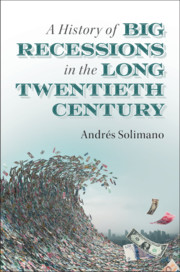Book contents
- A History of Big Recessions in the Long Twentieth Century
- A History of Big Recessions in the Long Twentieth Century
- Copyright page
- Dedication
- Contents
- Figures
- Tables
- Boxes
- Acknowledgments
- 1 Introduction
- 2 Recession and Depression
- 3 World War I, Hyperinflation in the 1920s, and World War II
- 4 The Great Depression of the 1930s
- 5 Stagflation in the 1970s, Globalization, and the Financial Crisis of 2008–2009
- 6 Two Depressions in the Early Twenty-First Century
- 7 Soviet-Type Socialism and the Postsocialist Transition
- 8 Economic Crises in Latin America and East Asia
- 9 Synthesis and Interpretation
- Appendix
- References
- Index
4 - The Great Depression of the 1930s
Published online by Cambridge University Press: 06 February 2020
- A History of Big Recessions in the Long Twentieth Century
- A History of Big Recessions in the Long Twentieth Century
- Copyright page
- Dedication
- Contents
- Figures
- Tables
- Boxes
- Acknowledgments
- 1 Introduction
- 2 Recession and Depression
- 3 World War I, Hyperinflation in the 1920s, and World War II
- 4 The Great Depression of the 1930s
- 5 Stagflation in the 1970s, Globalization, and the Financial Crisis of 2008–2009
- 6 Two Depressions in the Early Twenty-First Century
- 7 Soviet-Type Socialism and the Postsocialist Transition
- 8 Economic Crises in Latin America and East Asia
- 9 Synthesis and Interpretation
- Appendix
- References
- Index
Summary
Chapter 4 documents the worldwide intensity and duration of the Great Depression and focuses on the causes and consequences of the Depression in center and periphery economies. It examines the role played by the gold exchange standard, the lack of an international hegemonic power to coordinate and guide an effective international response to the shock, the response of monetary and fiscal policies, the timing of leaving the gold standard, and other factors. The chapter discusses the role of price deflation in exacerbating/ameliorating economic decline and the effects of war preparation in the United States, Germany, and other countries to put these economies back in a growth track.
Keywords
- Type
- Chapter
- Information
- Publisher: Cambridge University PressPrint publication year: 2020

